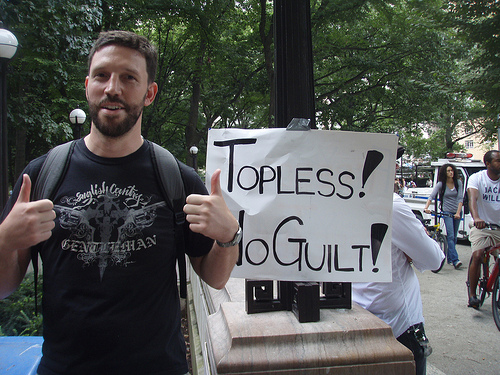By Joel Smart (The Cascade) – Email
Print Edition: July 18, 2012
When Moira Johnston goes for a walk in the summer heat, she tends to attract a fair amount of attention. That’s because, as a female rights activist, she’s trying to raise awareness that in the state of New York, where she lives, it’s perfectly legal for a woman to be topless in any space—public or not—where a man is allowed to be shirtless. It’s legal here too, and has been since 2008, but there is a reason why the majority of women still wouldn’t consider it.
Although many women are glad this bit of equality was fought for and won—and many admit how wonderful it sounds to be without the extra clothing on a hot day—actually going without a top in a public space seems like a nightmare for many.
That’s because our culture has sexualized the female breast. Women don’t want that added negative attention – the cat calls, the stares and the insults. They don’t want to be sexualized by every passerby they meet. But breasts aren’t sexual organs; their only difference from a male is the presence of fatty deposits. In many parts of the world, breasts aren’t treated the way they are here, and women feel totally at ease with them uncovered. We are the ones who decided a man’s chest is fine, but a woman’s is indecent.
The sexualized nature of breasts in our culture doesn’t just affect women wanting to cool down. It affects breastfeeding mothers who face hoards of offended strangers every time they feed their child. When mothers are asked to feed their children in the bathroom, it’s a sign that things have gone too far. We’ve got to change our attitude towards breasts.
Dave Quist, the executive directory of the Institute of Marriage and Family Canada, told The Georgia Straight in a 2008 interview that while he and many others respect the right of women to take off their tops, he still has an issue with it. “I don’t want their rights to interfere with my rights not to be offended, not to have my children see that, and so that’s where we run into conflict,” he said. Although no such right “not to be offended” exists, there is a debate about whether or not those with conservative values have a right to hide the sight of breasts from their children – by forcing women to keep them covered.
The easy solution seems to be to ask people to keep controversial activities out of the public sphere, but this argument is always used to reinforce the dominant views of a society – whether they’re sexist, ageist, racist, or otherwise unfair. Homosexuals, interracial couples, and transgendered folk have all been mistreated through this ideology.
Instead, the best course of action is to place individual rights and freedoms at the top of our list of priorities. Offended individuals, thankfully, will maintain the right to look away.
It is important—even for those offended—to realize that a woman without a top on is not asking for sexual comments, she’s not asking to be stared at or to have her breasts rated. She’s not acting like a “slut” or a “whore” – she’s not doing anything different than a topless guy. She’s not hurting anyone. Every argument to the contrary is socially-constructed sexism.
We should all be especially concerned when this sexism sneaks into our laws. Unlike in Vancouver, Seattle currently prohibits women from baring their breasts. Joedy Jaeks, a cancer survivor who had a double mastectomy, was victimized by this policy when she attempted to swim at her local pool without a top on. According to The National Post, wearing a top caused “searing pain” due to the scars on her chest. However, the Seattle Parks and Recreation department policy requires “gender appropriate” clothing, Jaeks told the paper. After a long process, Jaeks did receive a special exemption, but the policy has remained the same – even for other cancer patients.
Ultimately, policies like the one in Seattle (and the mindset of those who create and enforce them) are the leading cause of body shame. By labeling normal parts of our bodies “indecent” we teach our children a very unfortunate message – that our bodies are bad. This is reinforced time and time again by sexualized advertisements in the media that promote only specific body types. This shame is deeply embedded in us from a young age and has enormous influence over us. It’s not healthy. It holds us back. It makes us feel embarrassed and shy and powerless. But it can be overcome.
The first step in the healing process is to see normal bodies. Normal people with normal body parts are (you guessed it) totally normal. It only takes 10 seconds at Wreck Beach to recognize how varied body types can be, and how many of them we’re just not exposed to in our daily lives. No wonder we have such unrealistic expectations.
For Kimberly Parrott, a woman who often walks top free in New Westminster and Burnaby, it’s an incredibly important message for people to learn. “If people continue to say ‘look, bodies aren’t shameful!’ and teach their kids that there’s nothing wrong with nudity, then maybe in my lifetime the children will be able to say, ‘there’s nothing shameful about my body,’” she told The Georgia Straight. It’s an optimistic goal, but one that I am proud to support.


